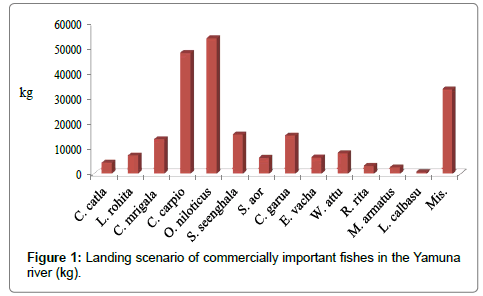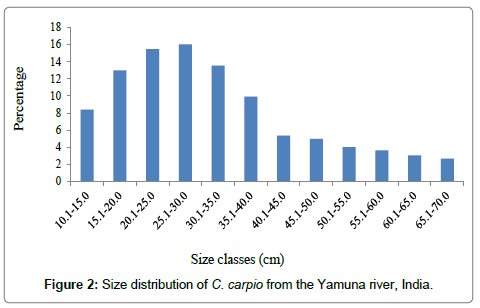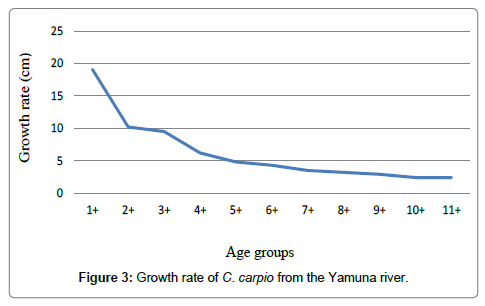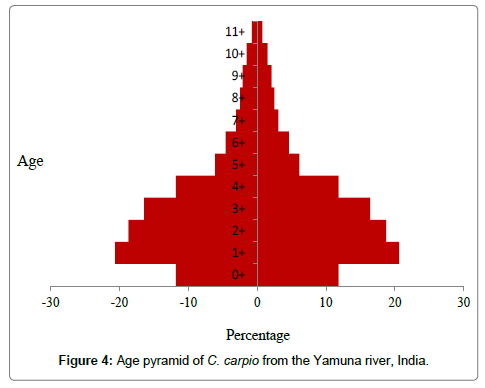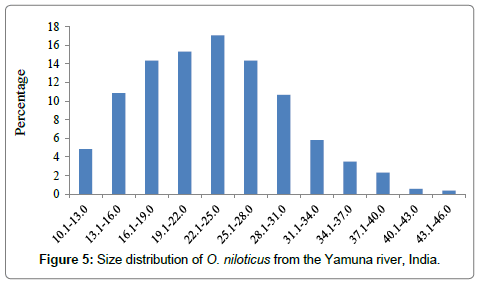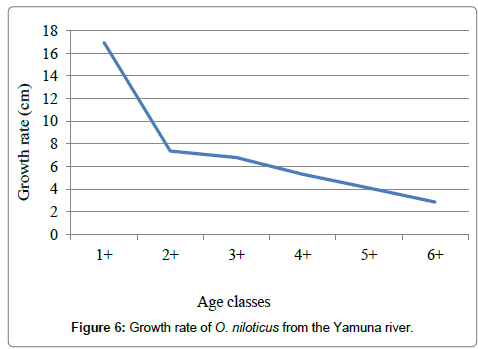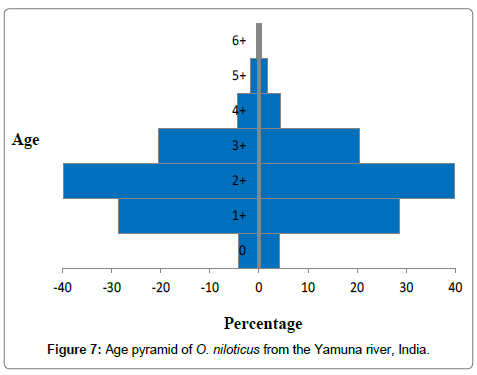Research Article Open Access
The River as Transformed by Human Activities: The Rise of the Invader Potential of Cyprinus carpio and Oreochromis niloticus from the Yamuna River, India
Amitabh Chandra Dwivedi*, Priyanka Mayank and Ashish TiwariRegional Centre, ICAR-Central Inland Fisheries Research Institute, 24 Panna Lal Road, Allahabad -211002, India
- *Corresponding Author:
- Dwivedi AC
Regional Centre, ICAR-Central Inland
Fisheries Research Institute
24 Panna Lal Road, Allahabad-211002, India
Tel: 033 2592 1190
E-mail: saajjjan@rediffmail.com
Received date: June 23, 2016; Accepted date: July 16, 2016; Published date: July 20, 2016
Citation: Dwivedi AC, Mayank P, Tiwari A (2016) The River as Transformed by Human Activities: The Rise of the Invader Potential of Cyprinus carpio and Oreochromis niloticus from the Yamuna River, India. J Earth Sci Clim Change 7:361. doi:10.4172/2157-7617.1000361
Copyright: © 2016 Dwivedi AC, et al. This is an open-access article distributed under the terms of the Creative Commons Attribution License, which permits unrestricted use, distribution, and reproduction in any medium, provided the original author and source are credited.
Visit for more related articles at Journal of Earth Science & Climatic Change
Abstract
Cyprinus carpio and Oreochromis niloticus are the most commercially exploited fishes in the Yamuna River, India. Study was undertaken during the period from August 2011 to July 2012 from the lower stretch of the Yamuna River. Analysis of the annual data on fish landing showed that Oreochromis niloticus and Cyprinus carpio have powerfully invaded the site due to poor water quality in the lower stretch of the Yamuna River at Allahabad in a big way. The estimated annual catch was dominated by O. niloticus followed by C. carpio and miscellaneous group as and they contributed for 24.36%, 21.76% and 15.22%, respectively. In case of Indian major carps, Cirrhinus mrigala shared maximum illegible with a contribution of 6.28%. The size composition of C. carpio varied from 10.4 to 69.7 cm while O. niloticus from 10.4-44.5 cm size groups rephrase. The 25.1-30.0 cm size group of C. carpio contributed maximum in the stock (16.03%) and in case of O. niloticus size group 22.1-25.0 cm shared maximum exploitation with 17.05%. The 0+ to 11+ age composition was recorded for C. carpio but in case of O. niloticus only 0+ to 6+ age groups recorded. The urn shaped age pyramid was recorded in both fishes. Unfortunately once C. carpio and O. niloticus establish a breeding population they are extremely difficult to eliminate in the open water. For conservation point of view C. carpio and O. niloticus species should be monitored in the Yamuna River. Both species are very harmful for fish biodiversity and abundance of indigenous fish species in the Yamuna River.
Cyprinus carpio and Oreochromis niloticus are the most commercially exploited fishes in the Yamuna River, India. Study was undertaken during the period from August 2011 to July 2012 from the lower stretch of the Yamuna River. Analysis of the annual data on fish landing showed that Oreochromis niloticus and Cyprinus carpio have powerfully invaded the site due to poor water quality in the lower stretch of the Yamuna River at Allahabad in a big way. The estimated annual catch was dominated by O. niloticus followed by C. carpio and miscellaneous group as and they contributed for 24.36%, 21.76% and 15.22%, respectively. In case of Indian major carps, Cirrhinus mrigala shared maximum illegible with a contribution of 6.28%. The size composition of C. carpio varied from 10.4 to 69.7 cm while O. niloticus from 10.4-44.5 cm size groups rephrase. The 25.1-30.0 cm size group of C. carpio contributed maximum in the stock (16.03%) and in case of O. niloticus size group 22.1-25.0 cm shared maximum exploitation with 17.05%. The 0+ to 11+ age composition was recorded for C. carpio but in case of O. niloticus only 0+ to 6+ age groups recorded. The urn shaped age pyramid was recorded in both fishes. Unfortunately once C. carpio and O. niloticus establish a breeding population they are extremely difficult to eliminate in the open water. For conservation point of view C. carpio and O. niloticus species should be monitored in the Yamuna River. Both species are very harmful for fish biodiversity and abundance of indigenous fish species in the Yamuna River.
Keywords
Oreochromis niloticus; Cyprinus carpio; Landing scenario; Yamuna River; Invader
Introduction
Fisheries of tropical rivers are very essential for the livelihoods and food security of millions of people around the world [1]. Fishery structure of the Yamuna River is in central India make majority of contributions to the nutrition needs and livelihoods of millions of people [2-4]. It is largest tributary of the Ganga river. Its length is about 1310 km. Near about twenty seven (27) species have been identified as having highest commercial value including Cyprinus carpio and Oreochromis niloticus in central India [5]. Both species are exotic for India and Indian sub-continents [6,7]. C. carpio and O. niloticus with a known capability to adjust to different environmental situation and its high prospective for aquaculture, can now be found in many rivers in India [8-10].
Introduction of non-native fish is a global phenomenon that has occurred for well over a century. C. carpio and O. niloticus have been intentionally spread around the world despite recognition of their potentially detrimental effects on native flora and fauna (open and close water bodies). C. carpio and O. niloticus are invasive fish species for India which was introduced intentionally in Indian water. Intentional introductions are, and have been, motivated by economic, environmental and social considerations. Invasive species generally disrupt recipient ecosystems leading to a loss of native biodiversity [11,12]. The invasion course is defined by a progression of stages [e.g., introduction, establishment (juvenile to brooder), spread] that are both biologically and environmentally filtered at each step [13]. C. carpio and O. niloticus are hardy fish that are well suited for aquaculture (specially poor water quality) and as result are the third and fifth most commonly introduced fish species in the world [2,9]. Both species has good potential for the enhancement of production in the fishery sector of India but these species highly contribution in riverine sector is very harmful. Nile tilapias exerts competition pressures on native fish and are known to prey on amphibians and juveniles of other fish species [14]. Tilapias are the second most important farmed fish globally next to carps and also as the most important aquaculture species of the twenty first century [15].
Fish is a rich source of protein, vitamins and minerals [16]. New knowledge on the role of omega-3 fatty acids in human physiology and their high contents in fish has added a new dimension to their importance in health and nutrition [2,17]. Freshwater fishes are the most imperiled vertebrate group with a projected extinction rate of five times that of terrestrial fauna and three times that of marine mammals [18,19]. The world natural fishery systems are collapsing as a direct result of overfishing and overcapacity of fishing fleets [20]. Fishes are important renewable natural resource and exploited both for subsistence and commercial purposes from rivers, streams, lakes, reservoirs, canals and wetlands [21]. Demand for fish and other aquatic products have recently rapidly increased due to enhanced immigration and gradual changes in many traditional customs [22].
The fish species contributing significantly to fishery have always been assessed through landings, largely to explain the fishery trends well exemplified by the riverine landings monitored regularly for the Ganga river as well as Yamuna river at Allahabad [23-28]. The condition of C. carpio and O. niloticus in India remains poorly understood, despite globally notoriety for its harmful impacts on freshwater ecosystems. Information of the invasive potential, size structure and fundamental landing of an aquatic invader is important feature for the development of effective rapid response plans and techniques. The objective of the present study was to give recent data regarding landing scenario and invasion profile of exotic fish species, C. carpio and O. niloticus from the Yamuna river, India.
Material and Methods
Study was undertaken during the period August 2011 to July 2012. For the purpose of collection of data on fish landings Sadiapur wholesale fish market was chosen. Sadiapur fish market is just by the left side of river Yamuna and major part of fish catch from the lower stretch of the river is brought to this market for disposal. Fishing was conducted by local fishermen with the help of using drag net, gill net, cast net, scoop net and hook and line.
For collection of data, Sadiapur fish market was visited early in the morning. Earlier studies have shown that bulk of the night catches from the lower stretch of river Yamuna is brought to this wholesale fish market for disposal. The data was collected species-wise (in case of commercially important fishes viz., Catla catla, Labeo rohita, Cirrhinus mrigala, C. carpio, O. niloticus, Sperata aor, S. seenghala, Clupisom garua, Eutropiichthys vacha, Wallago attu, Rita rita, L. calbasu and Mastacembelus armatus) and rest were recorded as miscellaneous. For the purpose of collection of data a stratified sampling design was adopted [29]. A month was divided in four strata of seven or eight consecutive days, depending upon the month and from each stratum data was collected for two randomly selected days. Data was collected by day unit.
The scale method has been used in the present investigations, as scales reflect faithfully changes in rate of growth and other valuable life history information. The Key scales were removed from the row above lateral line below dorsal fin region [30]. The scales were cleaned in 5% KOH solution to remove adhering- tissues and finally washed in distilled water. The scales were then pressed while drying in order to avoid their curling.
The age pyramid was prepared by Odum method [31]. The number of fish of each age group were recorded and converted into percentage to obtain a pyramid.
Results
The water quality of the Yamuna river was very poor (Table 1). The TDS was very high in the Yamuna river which indicated that the stock of the C. carpio was very high in the river. The BOD and COD were also very high. The fish landing data was recorded from Sadiapur wholesale fish market on sampling day and estimates were derived.
| Parameters | Yamuna river at Allahabad |
|---|---|
| Water Temperature  (°C) | 24.66 |
| pHÂ Â Â Â Â | 8.43 |
| Total Dissolved Solid (mgl-1)Â Â Â Â Â | 483.17 |
| SO4Â (mgl-1) | 67.33 |
| PO4 Â (mgl-1)Â Â | 1.19 |
| Alkalinity (mgl-1)Â Â Â Â | 183.33 |
| Total Hardness (mgl-1) | 174.66 |
| Nitrate (mgl-1) | 1.68 |
| Dissolved Oxygen (mgl-1)Â Â Â Â Â Â | 3.73 |
| BOD (mgl-1) | 29.41 |
| COD (mgl-1) | 23.17 |
| Chromium (mgl-1) | 0.05 |
| Cadmium (mgl-1)Â Â Â Â Â Â | 0.01 |
| Zinc (mgl-1)Â Â Â Â Â Â | 0.13 |
| Â Lead (mgl-1)Â Â Â Â Â | 0.12 |
Table 1: The water quality of the Yamuna river, India.
Annual landing
Analysis of data on fish landing showed that O. niloticus and C. carpio have invaded the lower stretch of the Yamuna river at Allahabad in a big way. The estimated annual catch was dominated by O. niloticus (147.81 kg day-1) followed by C. carpio (132.04 kg day-1) and miscellaneous group (92.34 kg day-1) and they accounted for 24.36%, 21.76% and 15.22%, respectively (Table 2). Annual estimates of landing data indicated that the Yamuna river at Allahabad region was most suitable for the O. niloticus. In case of Indian major carps, C. mrigala shared maximum with a contribution of 38.10 kg day-1 (6.28%). C. catla and L. rohita shared 12.69 kg day-1and 20.45 kg day-1, respectively (Table 2). In case of important catfishes, S. seenghala shared maximum (43.22 kg day-1). The average catch was 42.09 kg day-1 for C. garua (6.94.8%), 22.96 kg day-1 for Wallago attu (3.78%); 18.36 kg day-1 for E. vacha (3.03%); 17.93 kg day-1 for S. aor (2.96%) and 9.03 kg day-1 for Rita rita (1.49%). L. calbasu (7.49 kg day-1) contributed was low (1.23%) of the total catch. The contribution of Mastacembelus armatus was also low (2.26 kg day-1, 0.37%). It is likely that high fishing efforts will affect the size distribution and growth rate of C. carpio and O. niloticus from the Yamuna river, India.
| Group/Fish species | Average catch /day (kg) | Catch of year (kg) | Percentage |
|---|---|---|---|
| Indian major carps | |||
| Catlacatla | 12.69 | 4643 | 2.09 |
| Labeorohita | 20.45 | 7485 | 3.37 |
| Cirrhinusmrigala | 38.10 | 13945 | 6.28 |
| Exotic carps | |||
| Cyprinuscarpio | 132.04 | 48326 | 21.76 |
| Oreochromisniloticus | 147.81 | 54100 | 24.36 |
| Important catfishes | |||
| Sperataseenghala | 43.22 | 15817 | 7.12 |
| Sperataaor | 17.93 | 6564 | 2.96 |
| Clupisomagarua | 42.09 | 15405 | 6.94 |
| Eutropiichthysvacha | 18.36 | 6721 | 3.03 |
| Wallagoattu | 22.96 | 8404 | 3.78 |
| Rita rita | 9.03 | 3306 | 1.49 |
| Other important fishes | |||
| Labeocalbasu | 7.49 | 2742 | 1.23 |
| Mastacembelusarmatus | 2.26 | 828 | 0.37 |
| Miscellaneous | 92.34 | 33798 | 15.22 |
Table 2: Annual landing of fishes from the Yamuna river at Allahabad, India.
The estimated annual catch was higher for O. niloticus (54100 kg) than C. carpio (48326 kg) and miscellaneous (33798 kg). S. seenghala also shared good proportion with a contribution of 15817 kg (Figure 1). The annual catch of C. catla was 4643 kg; L. rohita 7485 kg; C. mrigala 13945 kg; S. aor 6564 kg; E. vacha 6721 kg; W. attu 8404 kg and R. rita 3306 kg (Table 1). By increasing the fishing effort, the yield can be increased to a certain level, but further increase in exploitation levels leads to reduction in the yield and if the effort is still further increased regardless of the reduction in total catch and catch rates, the stock under exploitation may collapse and the fishing community may have to face the problem of rehabilitation.
Cyprinus carpio
Size distribution of C. carpio: The distribution of fishes varied from 10.4 to 69.7 cm from the Yamuna river. The 25.1-30.0 cm size group of fishes contributed maximum in the stock (16.03%). The abrupt increased was observed from the size group 10.1-15.0-15.1-20.0 with 4.58%. Other size groups also figured in different proportion of which 20.1-25.0 cm (15.46%), 30.1-35.0 cm (13.55%), 35.1-40.0 cm (9.92%), 40.1-45.0 cm (5.34%), 45.1-50.0 cm (4.96%), 50.1-55.0 cm (4.01%) and 55.1-60.0 cm (3.62%) and small scale of remaining size groups (Figure 2). Overall lower size groups were maximum exploited. Lower size groups highly exploited compared to middle and higher size groups (Figure 2).
Growth rate: Marginal increment and edge analysis of C. carpio and O. niloticus scales from the Yamuna river, India indicated formation of one annuli per 12 month period.
Age composition of C. carpio caught from the river Yamuna varied from 0+ to 11+ age classes. The 11+ age group indicated the stock of C. carpio healthy in river. Annual ring formation (per year) was recorded in the present fish. Ring 1, 2 and 3…… were denoted to 1+ 2+ and 3+…. age of the fishes. The length ranged of 14.3-23.4, 20.5-32.3, 31.2- 43.3, 38.2-46.3, 43.1-49.2, 46.1-54.2, 52.6-57.8, 56.2-62.7, 61.8-66.8, 65.6-68.9 and 67.5-69.7 cm were recorded for the corresponding 1+, 2+, 3+, 4+, 5+, 6+, 7+, 8+, 9+, 10+ and 11+ age groups, respectively. The fish attained mean growth rate 19.1, 29.3, 38.8, 45.0, 49.8, 54.1, 57.6, 60.8, 63.7, 66.1 and 68.5 cm at the end of 1+, 2+, 3+, 4+, 5+, 6+, 7+, 8+, 9+, 10+ and 11+ years of the life, respectively. The maximum mean growth rate was attained in first year (19.1 cm) and minimum in the 10 and 11 year (2.4 cm each) of the life (Table 3). The fish exhibited higher growth rate in first three years of the life. The growth rate of fishes was found in systematic order (Figure 3). The systematic growth rate indicated that the stock of C. carpio has been well stable in the Yamuna river.
| Age classes | No. of specimens | Range (cm) | Mean length (cm) | Growth rate (cm) |
|---|---|---|---|---|
| 0+ | 62 | 10.4-15.8 | 14.3 | |
| 1+ | 108 | 14.3-23.4 | 19.1 | 19.1 |
| 2+ | 98 | 20.5-32.3 | 29.3 | 10.2 |
| 3+ | 86 | 31.2-43.2 | 38.8 | 9.5 |
| 4+ | 62 | 38.2-46.3 | 45.0 | 6.2 |
| 5+ | 32 | 43.1-49.2 | 49.8 | 4.8 |
| 6+ | 24 | 46.1-54.2 | 54.1 | 4.3 |
| 7+ | 16 | 52.6-57.8 | 57.6 | 3.5 |
| 8+ | 13 | 56.2-62.7 | 60.8 | 3.2 |
| 9+ | 11 | 61.8-66.8 | 63.7 | 2.9 |
| 10+ | 08 | 65.6-68.9 | 66.1 | 2.4 |
| 11+ | 04 | 67.5-69.7 | 68.5 | 2.4 |
Table 3: Age parameters of C. carpiofrom the Yamuna river, India.
Age pyramid: The urn shaped age pyramid was recorded in present study (Figure 4). The age group 1+ dominated by virtue of numbers in the Yamuna river (20.61%). The proportion of 0 age group (11.83%) was much less than 2+ age group (18.70%). The age groups 1+ and 2+ indicated that the small sized fish dominate the catch of C. carpio in the lower stretch of the Yamuna river. The middle age groups shared 16.41% (3+), 11.83% (4+), 6.11% (5+) and 4.58% (6+). The distribution was uneven between 0+ to 1+ and 4+ to 5+ age groups. The share abruptly increased between 0+ to 1+ age group with 8.79%. The percentage abruptly declined between 4+ to 5+ age groups as difference was about 5.72%.
Oreochromis niloticus (Nile tilapia)
Size distribution: The specimen of O. niloticus varying from 10.4-44.5 cm size groups. The size group 22.1-25.0 cm was maximum exploited with 17.05%. The abrupt increased was observed from the size group 10.1-13.0 to 13.1-16.0 cm (6.01%). The size groups 13.1- 16.0 cm, 16.1-19.0 cm, 19.1-22.0 cm, 25.1-28.0 cm, 28.1-31.0 cm, 31.1- 34.0 cm, 34.1-37.0 cm and 37.1-40.0 cm constituted 10.85%, 14.34%, 15.31%, 14.34%, 10.66%, 5.81%, 3.49% and 2.32%, respectively. The small proportion was shared by 40.1-43.0 and 43.1-46.0 with 0.58% and 0.39%, respectively (Figure 5).
Growth rate: On the basis of sampled specimen in the length range from 10.4 to 44.5 cm, it was observed that the fish attained the mean length 16.96 cm in 1+, 24.33 cm in 2+, 31.12 cm in 3+, 36.44 cm in 4+, 40.54 cm in 5+ and 43.50 cm in 6+ age group. The growth increment in O. niloticus was recorded 16.96 cm, 7.37 cm, 6.79 cm, 5.32 cm, 4.10 cm and 2.86 cm for 1+ to 6+ age groups, respectively (Table 4). It is obvious from the present observations the aquatic environment of Yamuna river at Allahabad was favourable to O. niloticus, and for the reason growth was good. The maximum growth increment was recorded in 1st year and minimum in 6th year of the life. The growth percentage varied from age to age in the samples (Figure 6). The advanced reproductive strategy of maternal mouth brooding in O. niloticus also influenced survival (age classes), proliferation and movement.
| Age | Size range (cm) | Mean length (cm) | Growth rate (cm) |
|---|---|---|---|
| 0+ | 10.4-14.2 | 12.61 | - |
| 1+ | 13.6-20.5 | 16.96 | 16.96 |
| 2+ | 18.2-29.0 | 24.33 | 7.37 |
| 3+ | 25.8-35.5 | 31.12 | 6.79 |
| 4+ | 32.4-39.7 | 36.44 | 5.32 |
| 5+ | 38.7-42.7 | 40.54 | 4.10 |
| 6+ | 42.5-44.5 | 43.4 | 2.86 |
Table 4: Physical condition - correlation of S1 compared with S2.
Age pyramid: During the research work, 516 specimens were examined for the estimation of age pyramid. The age groups varied from 0+ to 6+. Urn shaped pyramid was recorded (Figure 7). The age group 2+ dominated by virtue of numbers in the Yamuna river (39.73%). The proportion of 0 age group (4.26%) was much less than 1+ age group (28.68%). The age groups 1+ and 2+ indicated that the small sized fish dominate the catch of O. niloticus in the lower stretch of the Yamuna river. The higher age groups contributed 20.54% (3+), 4.46% (4+) and 1.74%. The distribution was uneven between 0+ to 1+ and 2+ to 3+ age groups. The share abruptly increased between 0+ to 1+. The percentage abruptly declined between 2+ to 3+ age groups as difference was about 19.19%.
Discussion
Widely distributed freshwater fish, C. carpio can be either invasive or naturalized in most areas [32]. Many freshwater ecosystems suffer from dense common carp (C. carpio). C. carpio is highly appreciated by many recreational fisheries, particularly in Europe and Asia [7]. Therefore, C. carpio has acquired world-wide importance in inland fisheries [8] and has been introduced and commonly stocked around the world to support commercial and recreational fisheries [33]. The occurrence of some invasive species is strongly related to habitat degradation, they replace native species [34]. The abundance of the O. niloticus ranged from 7-12% during 2008 (Kannauj to Ballia section) from the Ganga river [35,36], recorded that the O. niloticus, Tilapia zillii and O. aureus landed 51.29%, 36.24% and 5.59%, respectively in Rosetta branch of the Nile river.
After common carp, the miscellaneous and catfishes are emerging as the major fishery not only in the Ganga and Yamuna but also in the tributaries [21,27]. Stated that the annual average yield of Ganga river tended to decrease over the year (2001-2007). He observed that the highest average yield (3000 kg) was recorded in 2001, and the lowest average annual yields were recorded in 2006 (800 kg) and 2007 (900 kg), but the interval between fluctuated between 1100 and 2000 kg. [37-40] have discussed the ecology, fish and fisheries of Indian rivers and discussed the probable reasons for declining fisheries. The measures to mitigate the situation have also been suggested, have stated that due to heavy deforestation and other developmental activities in the catchment area silt load tremendously increased in Ganga at Allahabad and Varanasi. Such huge loading of silt resulted in severe hydrological degradation like in water holding capacity and volume in the river. As a result many wetlands lost connection with the main channel and some of them even lost their existence due to choking. Although no such information is available for river Yamuna but situation remains almost same for Yamuna.
Age composition of C. carpio caught from the river Yamuna varied from 1+ to 11+ age classes. The fish attained mean growth rate 19.1, 29.3, 38.8, 45.0, 49.8, 54.1, 57.6, 60.8, 63.7, 66.1 and 68.5 cm at the end of 1+ to 11+ years of the life, respectively. Growth rate may be strongly temperature-dependent and by inference, latitudinally dependent, although carp growth may also be depressed by increasing salinity [41]. Australian common carp have much higher growth rates from zero to 5 years of age compared with carp from Europe, Chile and New Zealand [42,43]. Conclusion that wild carp rarely attained ages in excess of 20 years is supported by the finding that no common carp older than 12 years of age were collected. The 0+ to 12+ age groups were recorded by Pathak et al. from the Ganga river, India with maximum growth in 2+ age group (19.03 cm).
In the present studies specimens O. niloticus measuring from 10.4 to 44.5 cm in 0+ to 6+ age groups. The studies showed that the fish attained the mean length of 16.96 cm in 1+, 24.33 cm in 2+, 31.12 cm in 3+, 36.44 cm in 4+, 40.54 cm in 5+ and 43.50 cm in 6+ age groups, observed ages of males and females O. niloticus ranged from 0 to 8 and 0 to 13 years, respectively in the Tabaru river, Yonaguni_jima, southwestern Ryukyu Archipelago Japan [44,45] reported slow growth rate of O. niloticus compared to present findings from tropical shallow lakes in Mexico. He recorded mean length as 10.61 cm in 1+, 12.43 cm in 2+ and 13.46 cm in 2.5+ age groups [46] cited for O. aureus that the rings on scales and opercular bones were due to periods of fast or slow growth imposed by reproductive energetic demands.
Present studies on the age pyramid of C. carpio revealed 0+ to 10+ while 0+ to 6+ in case of O. niloticus from the Yamuna river at Allahabad. [47] Observed that the age group 1+ of C. carpio was dominant (21.54%) and constituted nearly one fifth of the total population. The age groups 2+, 3+, 4+, 5+, 6+, 7+, 8+, 9+, 10+ and 11+ constituted 17.87%, 17.50%, 13.46%, 9.17%, 4.86%, 3.18%, 2.57%, 1.83%, 1.10%, and 0.73%, respectively from the Ganga river. It was the most dominant age group for O. niloticus with 67.48% in Rosetta branch of the Nile river [48] determined the population structure O. niloticus from the middle stretch of the Ganga river and recorded 0+ to 5+ age groups. Age group 2+ was dominated in the catch with 24.31%. 0+, 1+, 3+, 4+ and 5+ age groups constituted 16.85%, 24.31%, 15.74%, 11.05% and 5.25%, respectively. The distribution was systematic. Population structure indicated that in future O. niloticus population will increase.
Conclusion
It may be concluded that the C. carpio and O. niloticus are powerfully invaded in the Yamuna river due to poor water quality, India. The high percentage of landing, long age composition and high size distribution also agree in well establishment. Since, both species are exotic for the Yamuna river, India, conservation measures to protect these species.
References
- Welcomme RL (2008) World prospects for floodplain fisheries. Ecohydrology Hydrobiology8: 169-182.
- Mayank P, Dwivedi AC (2015 a) Biology of Cirrhinus mrigala and Oreochromis niloticus. LAP LAMBERT Academic Publishing GmbH & Co. KG, Germany, P:188.
- Mayank P, Dwivedi AC (2016) Stock assessment and population structure of alien fish species, Oreochromis niloticus(Linnaeus) from the lower stretch of the Yamuna river, India. J Experimental Zoology19: 163-167.
- ImranS, Thakur S, Jha DN,Dwivedi AC (2015) Size composition and exploitation pattern of Labeo calbasu (Hamilton 1822) from the lower stretch of the Yamuna river. Asian J Bio Sciences10: 171-173.
- Dwivedi AC,Mishra AS, Mayank P, Tiwari A (2016 a). Persistence and structure of the fish assemblage from the Ganga river (Kanpur to Varanasi section), India. J Geogr Nat Disast6: 159.
- Dwivedi AC, Tiwari A, Mayank P (2015) Seasonal determination of heavy metals in muscle, gill and liver tissues of Nile tilapia, Oreochromis niloticus (Linnaeus, 1758) from the tributary of the Ganga river, India. Zoology and Ecology25: 166-171.
- Pathak RK, Gopesh A, Dwivedi AC (2015) Invasion potential and biology of Cyprinus carpio (Common carp). LAP LAMBERT Academic Publishing GmbH & Co. KG, Dudweiler Landstr.Saarbrucken, Germany.
- Dwivedi AC,Nautiyal P (2013) Alien fish species, Cyprinus carpio (common carp) as a invader in the Vindhyan region (Ken, Paisuni, Tons rivers), India.J Kalash Sci1: 133-139.
- Mayank P, Dwivedi AC (2015 b) Role of exotic carp, Cyprinus carpio and Oreochromis niloticus from the lower stretch of the Yamuna river. In: Advances in biosciences and Technology,Pandeya KB, Mishra AS, Ojha RP, Singh AK (eds.) ,NGBU, Allahabad, P 93-97.
- Dwivedi AC, Mayank P, Imran S (2016 b) Reproductive structure of invading freshwater fish, Oreochromis niloticus (Linnaeus, 1757) in respect of climate from the tributary of the Ganga river, India. J Climatol Weather Forecasting 4:1-5.
- Gozlan RE, Britton JR, Cowx IG, Copp GH (2010) Current knowledge on non-native freshwater fish introductions. J Fish Biology44: 751-786.
- Zengeya TA, Booth AJ, Bastos ADS, Chimimba CT (2011) Trophic interrelationships between the exotic Nile tilapia, Oreochromis niloticus and indigenous tilapiine cichlids in a subtropical African river system (Limpopo River, South Africa). Environmental Biology of Fishes92: 479-489.
- Blackburn TM, Pysek P, Bacher S, Carlton JT, Duncan RP, et al. (2011) A proposed unified framework for biological invasions. Trends in Ecology & Evolution26: 333-339.
- Zambrano L, Martinez-Meyer E, Menezes N, Peterson AT (2006) Invasive potential of common carp (Cyprinus carpio) and Nile tilapia Oreochromis niloticus in American freshwater systems. Canadian J Fisheries Aquatic Sci63: 1903-1910.
- Shelton WL (2002) Tilapia culture in the 21st century. In: Guerrero RD III and Guerrero-Del Castillo MR (Eds.). Proceeding of the international forum on tilapia farming in the 21st century (Tilapia forum 2002), 184 P. Philippine Fisheries Association Inc. Los, Banos, Laguna, Philippines, 2002. pp: 1-20.
- Tiwari A, Dwivedi AC, Shukla DN, Mayank P (2014) Assessment of heavy metals in different organ of Oreochromis niloticus from the Gomti river at Sultanpur, India. J Kalash Sci2: 47-52.
- Tiwari A, DwivediAC (2014)Assessment of heavy metals bioaccumulation in alien fish species Cyprinus carpio from the Gomti river, India. European Journal of Experimental Biology 4: 112-117.
- Argent DG, Bishop JA, Stauffer JR, Carline RF, Myers WL (2003) Predicting freshwater fish distributions using landscape-level variables. Fisheries Research60:17-32.
- Cooke SJ, Bunt CM, Hamilton SJ (2005) Threats, conservation strategies, and prognosis for suckers (Catostomidae) in North America: insights from regional case studies of a diverse family of non-game species. Biological Conservation121:317-331.
- Yakubu A, Li N, Conrad J, Zeeman ML (2011) Fish population dynamics and constant or periodic proportion harvesting policies. Mathematical Biosciences232: 66-77.
- Dwivedi AC, Nautiyal P (2010)Population dynamics of important fishes in the Vindhyan region, India.LAP Lambert Academic Publishing, Germany, Pp 220.
- Jia Yin-Tao, Chen Yi-Feng (2011) Age structure and growth characteristics of the endemic fish for Oxygymnocypris stewartii (Cypriniformes: Cyprinidae: Schizothoracinae) in the Yarlung Tsangpo river, Tibet. Zoological Studies50: 69-75.
- Gupta RA, Tyagi RK (1992) Analytical approach to analysis of fish stock of Ganga river system. J Inland Fisheries Society24: 20-27.
- Singh HR, Payne AI, Pandey SK, Singh PR (1998). Time scale changes in the catch structure of fishery in Allahabad. Proceeding of the National Academy Science India 68B: 15-21.
- Vass KK, Tyagi RK, Singh HP, Pathak V (2010). Ecology, changes in fisheries, and estimates in the middle stretch of the river Ganges. Aquatic Ecosystem and Health Management13: 374-384.
- Pathak RK, Gopesh A, Dwivedi AC (2011) Alien fish species, Cyprinus carpio var. communis (common carp) as a powerful invader in the Yamuna river at Allahabad, India. National Academy of Science Letter,34: 367-373.
- Anon 2010. (Annual Report) Central Inland Fisheries Research Institute (ICAR), Barrackpore, Calcatta, West Bengal.
- Anon (2013) (Annual Report) Central Inland Fisheries Research Institute (ICAR), Barrackpore, Calcatta, West Bengal.
- Tyagi RK, Mandal SK (2008) Sampling methodologies for estimation of inland fish catch in India. CIFRI, Barrackpore WB P: 71.
- Bagenal T, Tesch F (1978) Age and Growth. In:Methods for Assessment of Fish Production in Fresh Waters Edited by T. Bagenal, Blackwell Scientific Publication Oxford 3rd Editionpp:101-136.
- Odum EP (1971) Fundamentals of ecology. Saunders College Publishing Phialadelphia P A 3rd edition, Pp. 3-574.
- Vilizzi L, Tarkan AS, Copp GH (2015) Experimental evidence from causal criteria analysis for the effects of common carp Cyprinus carpio on freshwater ecosystem: a global perspective. Rev Fisheries Sci Aqua23: 253-290.
- FAO (2010) State of world fisheries and Aquaculture 2004, fisheries Department, Rome.
- Casatti, L, Teresa FB, Goncalves-Souza T, Bessa E, Manzotti AR, Goncalves CS, Zeni JO (2012) From forests to cattail: how does the riparian zone influence stream fish? Neotropical Ichthyology10: 205-214.
- Singh AK, Verma P, Srivastava SC, tripathi M (2014) Invasion, biology, and impact of feral population of Nile tilapia (Oreochromis niloticus Linnaeus 1757) in the Ganga river (India). Asia Pacific J Res1: 151-163.
- Hatem MH, Marwa MM (2008) Biology and fisheries management of Tilapia species in Rosetta branch of the Nile river, Egypt. Egyptian J Aqua Res34: 272-284.
- Montana CG, Choudhary SK, Dey S, Winemiller KO (2011). Composition trends of fisheries in the River Ganges, India. Fisheries Management and Ecology18: 282-296.
- Vass KK, Das MK, Tyagi RK, Katiha PK, Samanta S, et al. (2011) Strategies for sustainable fisheries in the Indian part of the Ganga-Brahmaputra basins. International Journal of Ecology and Environmental Science,37: 157-218.
- Vass KK, Tyagi RK, Pathak V, Singh HP, Seth RN (2008) The status of the river Ganges in the middle stretch. CIFRI Bull154: 25
- Pathak V, Tyagi RK (2010) Riverine ecology and fisheries vis-Ã -vis hydrodynamic alterations: Impacts and remedial measures. CIFRI Bull161: 33.
- Wang JQ, Lui HL, Poand HY, Fan LN (1997) Influence of salinity on food consumption, growth and energy conversion efficiency of common carp (Cyprinus carpio) fingerlings. Aquaculture148:115-124.
- Vilizzi L, Walker KD (1999) Age and growth of the common carp, Cyprinus carpio, in the river Murray, Australia: validation, consistency of age interpretation and growth models. Environmental Biology of Fishes 54:77-106.
- McCrimmon HR (1968) Carp in Canada. FishRes Board Canada Bull 165: 1-89.
- Ishikawa T, Shimose T, Tachihara K (2013) Life history of an invasive and unexploited population of Nile tilapia (Oreochromis niloticus) and geographical variation across its native and non-native ranges. Environmental Biology of Fishes96: 603-616.
- Gomez Marquez JL, Pena Mendoza B, Salgado-Ugarte IH, Arredondo-Figueroa JL (2008) Age and growth of the tilapia Oreochromis niloticus (Perciformes: Cichlidae) from a tropical shallow lake in Mexico. Revista de Biologia Tropical56: 875-884.
- Jimenez-Badillo, (2006) Age-growth models for tilapia Oreochromis aureus (Perciformes, Cichlidae) of the Infiernillo reservoir, Mexico and reproductive behavior. Revista de Biologia Tropical54:577-588.
- Pathak RK, Gopesh A, Joshi KD, Dwivedi AC (2013) Cyprinus carpio var. communis in middle stretch of river Ganga at Allahabad. J Inland Fisheries 45: 60-62.
- DwivediAC, Jha DN (2013) Population structure of alien fish species, Oreochromis niloticus (Linnaeus, 1757) from the middle stretch of the Ganga river, India. Journal of the Kalash Science1: 157-161.
Relevant Topics
Recommended Journals
Article Tools
Article Usage
- Total views: 12024
- [From(publication date):
July-2016 - Jul 03, 2024] - Breakdown by view type
- HTML page views : 11276
- PDF downloads : 748

